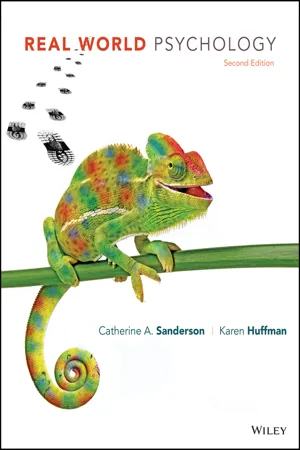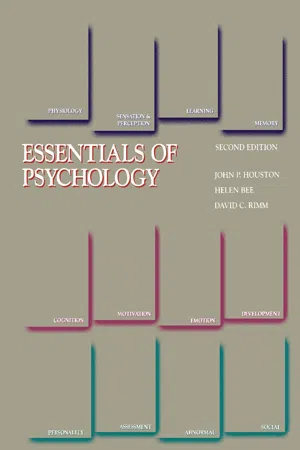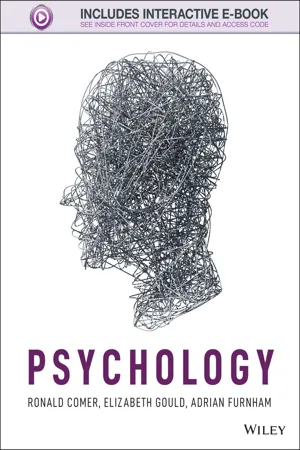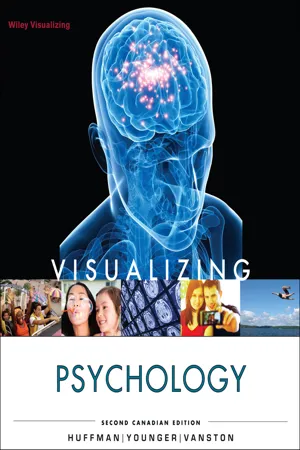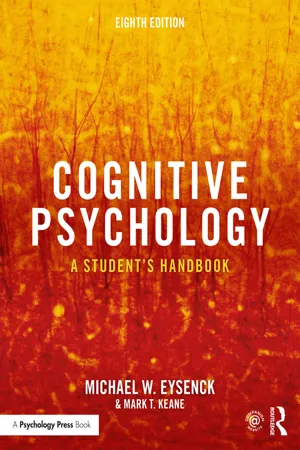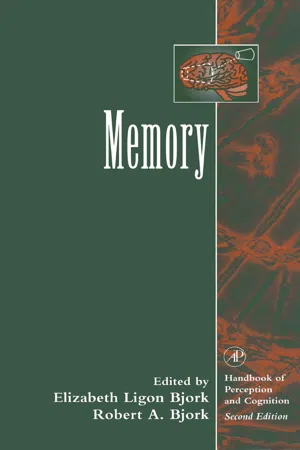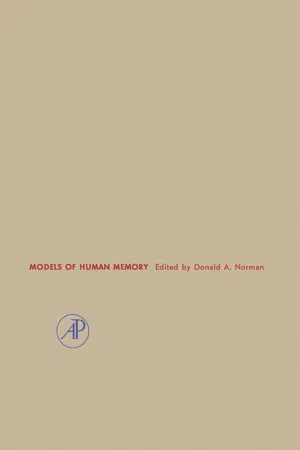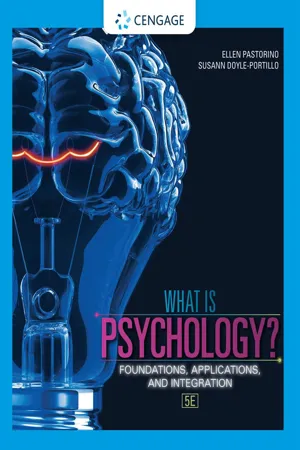Psychology
Memory
Memory refers to the mental processes involved in encoding, storing, and retrieving information. It encompasses various types of memory, including sensory, short-term, and long-term memory. Memory plays a crucial role in cognitive processes such as learning, problem-solving, and decision-making.
Written by Perlego with AI-assistance
Related key terms
1 of 5
11 Key excerpts on "Memory"
- eBook - PDF
- Rose M. Spielman, William J. Jenkins, Marilyn D. Lovett(Authors)
- 2020(Publication Date)
- Openstax(Publisher)
Memory is the set of processes used to encode, store, and retrieve information over different periods of time ( Figure 8.2). FIGURE 8.2 Encoding involves the input of information into the Memory system. Storage is the retention of the encoded information. Retrieval, or getting the information out of Memory and back into awareness, is the third function. LINK TO LEARNING Watch this video about the neuroscience of Memory (http://openstax.org/l/unexpectfact) to learn more. Encoding We get information into our brains through a process called encoding, which is the input of information into the Memory system. Once we receive sensory information from the environment, our brains label or code it. We organize the information with other similar information and connect new concepts to existing concepts. Encoding information occurs through automatic processing and effortful processing. If someone asks you what you ate for lunch today, more than likely you could recall this information quite easily. This is known as automatic processing, or the encoding of details like time, space, frequency, and the meaning of words. Automatic processing is usually done without any conscious awareness. Recalling the last time you studied for a test is another example of automatic processing. But what about the actual test material you studied? It probably required a lot of work and attention on your part in order to encode that information. This is known as effortful processing ( Figure 8.3). FIGURE 8.3 When you first learn new skills such as driving a car, you have to put forth effort and attention to encode information about how to start a car, how to brake, how to handle a turn, and so on. Once you know how to drive, you can encode additional information about this skill automatically. (credit: Robert Couse-Baker) What are the most effective ways to ensure that important memories are well encoded? Even a simple sentence is easier to recall when it is meaningful (Anderson, 1984). - eBook - PDF
- Catherine A. Sanderson, Karen R. Huffman(Authors)
- 2016(Publication Date)
- Wiley(Publisher)
© evemilla/iStockphoto © John Cooke/iStockphoto 174 The Nature of Memory 175 7.1 The Nature of Memory LEARNING OBJECTIVES Retrieval Practice While reading the upcoming sections, respond to each Learning Objective in your own words. Summarize the key factors, research findings, and major models of Memory. • Define Memory and its constructive process. • Discuss the two major Memory models. • Explain the function and process of sensory Memory. • Review the core principles of short-term Memory (STM) and how it compares to working Memory. • Describe the core features, functions, and various types of long-term Memory (LTM), and how to improve it. Memory is learning that persists over time. It allows us to learn from our experiences and to adapt to ever-changing environments. Without it, we would have no past or future. Yet our memories are highly fallible. Although some people think of Memory as a gigantic library, or an automatic video recorder, our memories are not exact recordings of events. Instead, mem- ory is highly selective (Baddeley et al., 2015; Chen & Wyble, 2015; Matlin & Farmer, 2016). As discussed in Chapter 5, we only pay attention to, and remember, a small fraction of the information we’re exposed to each day. Perhaps most important, Memory is a constructive process through which we actively organize and shape information as it is being encoded, stored, and retrieved (Herriot, 2014; Karanian & Slotnick, 2015; Robins, 2016). As expected, this construction often leads to serious errors and biases, which we’ll discuss throughout the chapter. Would you like personal proof of the constructive nature of your own Memory? See the following Psychology and You. Memory The persistence of learning over time; process by which information is encoded, stored, and retrieved. Constructive process The process of organizing and shaping information during encoding, storage, and retrieval of memories. - eBook - PDF
- John P. Houston, Helen Bee, David C. Rimm(Authors)
- 2013(Publication Date)
- Academic Press(Publisher)
This new approach con-ceives of the human being as an information*processing system. Accord-ing to this way of thinking, Memory involves the flow of information through the organism, beginning with encoding and storage and ending with the retrieval of stored information. The number of specific models of Memory that have developed within this new tradition is quite astounding (see Atkinson & Shiffrin, 1971; Broadbent, 1971; Craik & Lockhart, 1972; Hilgard & Bower, 1975; Lind-say & Norman, 1977; Ratcliff, 1978; Wickelgren, 1979). We will con-sider a model of Memory that represents a distillation of several different models, because many of the available models agree with one another in important ways. These areas of agreement are summarized by the flow diagram in Figure 5. Notice that the model in Figure 5 contains three distinct types of Memory—sensory Memory, short-term Memory, and long-term Memory. Most recent information-processing models define three types of Memory, while the older interference theory specifies only one Memory process. In Figure 5 information is presumed to move through these three Memory systems from left to right. Perceived information first FIGURE 5 The three human Memory systems. Stimulus Sensory Memory Rehearsal Short-term Memory Long-term Memory Retrieval o / 7 V 174 Chapter 5 Memory enters sensory Memory; it may then be transferred to short-term Memory, and finally to long-term Memory. In essence, the argument for having three memories, or stores, is that the ways in which we remember items for very short periods of time differ from the ways in which we remember the same items for long periods of time, For example, if you wanted to remember 193-2040 for a very short time (say, 30 seconds), you might do it by remembering the sounds of the numbers and by arranging these sounds into some easily remembered pattern or rhythm such as one-nine-three-twenty-forty. - eBook - PDF
- Ronald Comer, Elizabeth Gould, Adrian Furnham(Authors)
- 2014(Publication Date)
- Wiley(Publisher)
• Storage – Retaining memories for future use. • Retrieval – Recapturing memories when we need them. These three stages work together. For any single Memory event, all three need to have been achieved. In Memory clin- ics, neurologists sometimes ask people to report what they had for breakfast. You can consider this simple question now, and form an answer. To be able to report this informa- tion, you need to have been paying attention to breakfast in the first place in order to encode it, then information con- cerning breakfast needs to have been meaningfully stored and, finally, when asked, you need to successfully travel back (mentally) to the right time point and to the right informa- tion. This may even involve some mental effort, or the sen- sation that information is rushing back. But a disruption to any of these three stages will mean that the information is lost, even if only temporarily. How do we manage to encode, store and retrieve infor- mation? Psychologists have developed a number of models of explanation, including the information-processing model and the parallel distributed-processing model, or connectionist model. The information-processing model of Memory holds that information must pass through three stages, or systems, of mental functioning in order to become a firmly implanted Memory: sensory mem- ory, working Memory and long-term Memory (Figure 10.1) (Dudai, 2011; Nee et al., 2008). When we first come across a stimulus, we retain a sensory image – or sensory Memory – of it for less than a second. Sensory memories help us to keep alive items that we have experienced briefly a bit longer, so that we can, in a sense, decide whether to pay further atten- tion to them. If, for example, we are copying from one piece of text while typing, we will store a brief sketch of where in the document we are looking, before turning to the computer and turning back again. - Lorelle J. Burton, Drew Westen, Robin M. Kowalski(Authors)
- 2022(Publication Date)
- Wiley(Publisher)
Varieties of long-term Memory • Declarative Memory refers to Memory for facts and events; it can be semantic Memory or episodic Memory. Procedural Memory refers to ‘how to’ knowl- edge of procedures or skills. • Explicit Memory refers to conscious recollection. Implicit Memory refers to Memory that is expressed in behaviour. • Everyday Memory refers to Memory as it occurs in daily life. Remembering, misremembering and forgetting • Psychologists often distinguish between the availability of information in Memory and its accessibility. • People make Memory errors for a variety of reasons. • Psychologists have proposed several explanations for why people forget, including decay, interference and motivated forgetting. • Memories recovered in therapy cannot be assumed to be accurate, but they also cannot be routinely dismissed as false. • Specifc kinds of distortion can also occur within the memories of people whose brains have been affected by illness or injury. Anterograde amnesia involves the inability to retain new memories. By contrast, retrograde amnesia involves losing memories from a period before the time that a person’s brain was damaged. Encoding and organisation of long-term Memory • To be retrieved from Memory, information must be encoded, or cast into a representational form or ‘code’ that can be readily accessed. • Mnemonic devices are systematic strategies for remembering information. • Knowledge stored in Memory forms networks of association — clusters of interconnected information. • LTM is organised in terms of schemas, organised knowl- edge structures or patterns of thought. Pdf_Folio:448 Information processing • sensory • verbal • motoric Short-term Memory (20–30 seconds) Response Retrieval Rehearsal Long-term Memory (enduring storage) Sensory Memory A Memory is a mental representation for something to be remembered.- eBook - PDF
- Karen R. Huffman, Katherine Dowdell, Catherine A. Sanderson(Authors)
- 2017(Publication Date)
- Wiley(Publisher)
Summarize the key factors, research findings, and major models of Memory. • Define Memory and its constructive process. • Discuss the four major Memory models. • Explain the function and process of sensory Memory. • Review the core principles of short-term Memory (STM) and how it compares to working Memory. • Describe the core features, functions, and various types of long-term Memory (LTM), and how to improve it. ©AP/Wide World Photos 222 CHAPTER 7 Memory memories in the future. Can you see why psychologists are so fascinated by Memory and why it’s generally defined as learning that persists over time? Why should you be interested in this chapter? You may have noticed that people often create journals and collect souvenirs on their trips, along with taking literally thousands of photos of themselves and their everyday lives. Given such common and obvious efforts to collect concrete evidence of experiences to preserve memories, it’s ironic that the public tends to think of Memory as a gigantic library or an automatic video recorder. As you’ll discover later in this chapter, our memories are, in fact, highly fallible and very selective, and the public’s unwarranted faith in eyewitness testimony has led to serious problems in legal settings and other situations (Baddeley et al., 2015; Matlin & Farmer, 2016; Wan et al., 2017). In reality, studies find that Memory is a constructive process through which we actively organize and shape information as it is being encoded, stored, and retrieved (Herriot, 2014; Karanian & Slotnick, 2015; Robins, 2016). This construction often leads to serious errors and biases, which we’ll discuss throughout the chapter. If you’d like proof of the constructive nature of your own Memory, see the following Try This Yourself. Memory The persistence of learning over time; process by which information is encoded, stored, and retrieved. - eBook - PDF
- Karen R. Huffman, Alastair Younger, Claire Vanston(Authors)
- 2013(Publication Date)
- Wiley(Publisher)
184 ❑ ■ p. 188 ❑ ■ p. 199 ❑ ■ ❏ Applying Psychology, p. 186 ❑ ■ p. 193 ❑ ■ p. 202 ❑ ■ ❏ What a Psychologist Sees, p. 187 ■ ❏ Study Organizer, p. 189 ■ ❏ Visualizing, p. 192 ■ ❏ Psychological Science, p. 196 ❑ ■ p. 200 ❑ ■ ❏ Stop: Answer the Concept Checks before you go on: p. 194 ❑ ■ p. 198 ❑ ■ p. 201 ❑ ■ p. 205 ❑ End of chapter ■ ❏ Review the Summary and Key Terms. ■ ❏ Answer the Critical and Creative Thinking Questions. ■ ❏ Complete the Self-Test and check your answers. ✓ ✓ The Nature of Memory LEARNING OBJECTIVES emory allows us to profit from our experiences and to adjust to ever-changing environments. Without Memory we would not learn from past events or adapt to future situations. Consider Henry Molaison for a second as you read this paragraph; it is Memory that makes the present meaningful and the future understandable. Yet our memories are also highly fallible. Although some people think of Memory as a gi- gantic library or an automatic event recorder, our memories are never perfect records of events. Instead, Memory is a constructive and re-creative process through which we actively organize and shape information. Memory is 1. Review the principles of the two major Memory models. 2. Describe the different purposes of sensory Memory, short-term Memory, and long-term Memory. 3. Understand the relationship between short- term Memory and working Memory. 4. Identify ways of extending the duration and capacity of short-term Memory. 5. Describe the various types of long-term Memory. 6. Explain how organization, elaborative rehearsal, and retrieval cues improve long-term Memory. M malleable. As you might expect, the belief that Memory is accurate and precise often leads to serious errors and biases, which we’ll discuss throughout this chapter. How Does Memory Work? Over the years, psychologists have developed numer- ous models (or abstract representations) of how Memory might operate. - eBook - PDF
Cognitive Psychology
A Student's Handbook
- Michael W. Eysenck, Mark T. Keane(Authors)
- 2020(Publication Date)
- Psychology Press(Publisher)
Others argue that there are numerous processes that are combined and recombined depending on the specific demands of any given Memory task. Memory is important in everyday life in ways de-emphasised historically. For example, autobiographical Memory (discussed in Chapter 8) is of great significance to us. It gives us a coherent sense of ourselves and our person- alities. The other topics considered in Chapter 8 are eyewitness testimony and prospective Memory (Memory for future intentions). Research into eye- witness testimony has revealed that eyewitness testimony is often much less accurate than generally assumed. This has implications for the legal system because hundreds of innocent individuals have been imprisoned solely on the basis of eyewitness testimony. When we think about Memory, we naturally focus on Memory of the past. However, we also need to remember numerous future commitments (e.g., meeting a friend as arranged), and such remembering involves prospective Memory. We will consider how we try to ensure we carry out our future intentions. The study of human Memory is fascinating, and substantial progress has been made. However, it is complex and depends on several factors. Four kinds of factors are especially important: events, participants, encoding and retrieval (Roediger, 2008). Events range from words and pictures to texts and life events. Participants vary in age, expertise, Memory-specific dis- orders and so on. What happens at encoding varies as a function of task instructions, the immediate context and participants’ strategies. Finally, Memory performance at retrieval often varies considerably depending on the nature of the Memory task (e.g., free recall; cued recall; recognition). The take-home message is that Memory findings are context-sensitive – they depend on interactions between the four factors. - eBook - PDF
- Elizabeth Ligon Bjork, Robert A. Bjork(Authors)
- 1996(Publication Date)
- Academic Press(Publisher)
Encoding refers to any mental operations performed on information arriving in the sensory systems that form Memory traces of that information. Elaboration refers to the establishing of linkages between new information and previ- ously stored information, a process that seems to be especially effective at promoting long-term storage of new information. Retrieval refers to the process of bringing information out of Memory for current use. These four concepts are useful in describing activities involved in the use of Memory stores. More debatable is the utility of another concept that is widely used in this connection: the concept of attention. This term is used so frequently in ordinary discussion and in psychological theorizing that one is tempted to acceptJames's statement that everyone knows what attention is (James, 1890). When the goal is to understand mental phenomena at a mechanistic level, however, it may be better to assume that no one knows what attention is, and even to assume that there is probably no it there to be understood. The fact that our commonsense understanding of attention sprawls over so much of the mental landscape is particularly worrisome. On one hand, we talk about attention to refer to our selective control over the intake of information from the senses, as in the cocktail-party effect. On the other hand, we use the term attention to refer to just about any limitation on mental activity, including limits on how much information we can take in at any time, how many tasks we can carry out, and how long we can keep performing well in a single task. All of these things are routinely described and explained in terms of movement, shifts, depletions, or reductions in attention. There is no doubt that voluntary control over sensory input and capacity limitations are real phenomena. It seems very doubtful, though, that we have any privileged access to mental operations, especially as they occur on a rapid time scale. - eBook - PDF
- Donald A. Norman(Author)
- 2013(Publication Date)
- Academic Press(Publisher)
The general picture of human information processing is this. First, newly presented information would appear to be transformed by the sensory system into its physiological representation (which may already involve a substantial amount of processing on the initial sensory image), and this representation is stored briefly in a sensory information storage system. Following this sensory storage, the presented material is identified and encoded into a new format and retained temporarily in a different storage system, usually called short-term Memory. Then, if extra attention is paid to the material, or if it is rehearsed frequently enough, or if it gets properly organized, the information is transferred to a more permanent Memory system (or, in some models, the rate at which it decays decreases substantially). In general, the capacity of this more permanent storage is so large that information that is stored there must be organized in an efficient manner if it is ever to be re-trieved. Then, finally, when it is necessary to retrieve information from Memory, decision rules must be used, both to decide exactly how to get access to the desired information and then to decide exactly what response should be made to the information that has been retrieved. Most of the authors of the chapters in this volume agree with this general picture, although each chapter emphasizes different aspects of the system and different chapters usually make different assumptions about the details of the processes. Most authors assume that there are three different types of Memory storage systems: a sensory information storage, a short-term Memory, and a long-term Memory. Everyone ac-cepts the need for a sensory information storage. Some, however, do not believe that there is any need to distinguish between short- and long-term Memory (Bernbach, Chapter 4; Murdock, Chapter 9). - eBook - PDF
What is Psychology?
Foundations, Applications, and Integration
- Ellen Pastorino, Susann Doyle-Portillo, Ellen Pastorino(Authors)
- 2021(Publication Date)
- Cengage Learning EMEA(Publisher)
CHAPTER 7 Memory 294 Suppose a bee stings you. Your haptic (touch) sensory Memory registers the pain of the sting, and your visual sensory Memory captures the sight of the bee. These sensory impres- sions are then sent to working Memory, where they are com- bined into an integrated Memory representation of being stung by the bee (Kessler & Meiran, 2006). At the same time, your working Memory may activate a long-term Memory of what you learned in first-aid class about the dangers of allergic reac- tions to bee stings. Working Memory accesses this information on allergic reactions, and you now consciously think about the signs of an allergic reaction as you check to see whether you are having one. You conclude that you are not having an al- lergic reaction, so you cease to think about it, and working Memory transfers the new knowledge that you are not allergic to bee stings to long-term Memory. As you can see, in this view of Memory, information does not flow sequentially from sensory to short-term to long-term Memory. Rather, working Memory plays several roles. Much like short-term Memory, working Memory acts as a temporary storage system for information that is currently being used. However, at the same time, other parts of working Memory act to retrieve information, process new information, and send new and revised information on to long-term Memory. The order in which the different Memory stages are activated can vary depending on the circumstances. One advantage of the working Memory model is that it can explain why we sometimes seem to access long-term Memory before we process information in short-term Memory. For instance, as you read this page, you must access information that you have stored in long-term Memory about the English language in order to pronounce and understand the words. As the words on the page enter your short-term Memory, you already know what they mean and how they sound.
Index pages curate the most relevant extracts from our library of academic textbooks. They’ve been created using an in-house natural language model (NLM), each adding context and meaning to key research topics.

